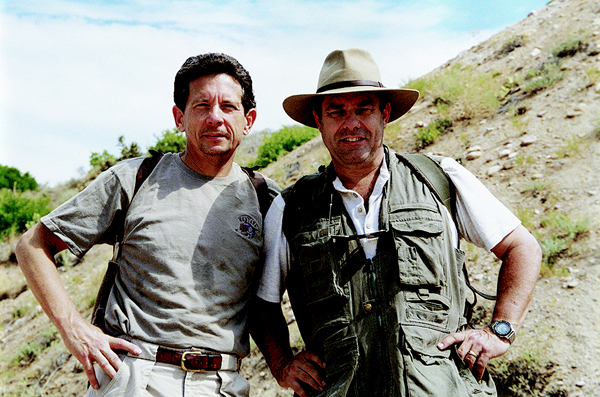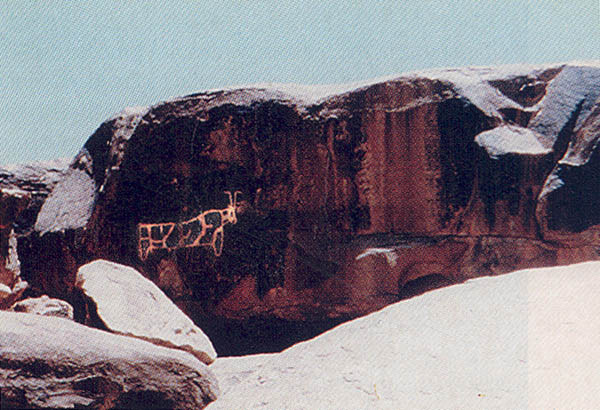Did Amateur Archaeologists Find the Real Mt. Sinai?
Sidebar to: Mt. Sinai—in Arabia?036
In 1988 Wall Street millionaire Larry Williams and ex-cop Bob Cornuke snuck into Saudi Arabia on a mission to explore what they believed was the real Mt. Sinai—Jebel al-Lawz. Using the Book of Exodus as their guide, they searched the 8,500-foot-high peak for evidence that this was the site where Moses received the Ten Commandments.
Williams (at left in the photo below) and Cornuke (at right) were following in the footsteps of the self-proclaimed archaeologists Ron Wyatt and David Fasold, who visited the mountain in 1986 hoping to find the “gold of Exodus”—the Egyptian jewelry that they believed the Israelites had brought with them from Egypt (Exodus 12:35–36). Wyatt and Fasold did not get far: After only one morning on the mountain, they were arrested for illegal excavation, threatened with capital punishment and deported.

Knowing of Larry Williams’s interest in biblical finds and of his wealth, Fasold informed the millionaire of their curtailed excavations and told him that his metal detector had indicated that the plains around Jebel al-Lawz were rich with buried gold. Enticed, Williams in turn contacted Cornuke, a former policeman with a reputation for bravery. Together, they decided to enter Saudi Arabia illegally and explore Mt. Sinai. The story of their clandestine trip to Jebel al-Lawz has been recounted in videos and books—including the New York Times best-seller The Gold of Exodus, by Howard Blum.a
Like others before them, Williams and Cornuke identify Jebel al-Lawz as Mt. Sinai primarily because it is the highest mountain in what some scholars identify as the ancient region of Midian. They also note that the summit is black and appears to be composed of charred rock, recalling the description in Exodus: “Mount Sinai was wrapped in smoke, because the Lord had descended upon it in fire; the smoke went up like the smoke of a kiln” (Exodus 19:18). Further, the vast open space surrounding the mountain, they suggest, could have supported the multitude of Israelites, and a nearby plain could have served as the battleground of Rephidim (Exodus 17:8–13).

Poking around the fenced-off site, Williams and Cornuke searched for further correspondences with the biblical record. Near the foot of the mountain, they spotted a stack of boulders bearing petroglyphs (rock drawings) of bulls: This, Williams and Cornuke suggest, might be the altar where the Israelites worshiped the golden calf (photo, above). Also around the base of the mountain, the pair found a long line of widely spaced rock piles, or cairns, that they suggest may be the boundary markers erected by Moses around the base of Mt. Sinai: “The Lord said to Moses, ‘…You shall set bounds for the people round about, saying “Beware of going up the mountain or touching the border of it”’” (Exodus 19:10–12).
Higher up the slope, Cornuke and Williams found a large stone structure resembling a building foundation with two wings (each 30 by 65 feet) meeting at right angles. Next to the structure they discovered the remnants of marble columns. Nearby Cornuke and Williams found the remains of what they identify as 12 large stone towers, each about 18 feet in diameter. They tentatively identify the foundation with the altar constructed by Moses in Exodus 24; the towers, with the 12 037pillars Moses erected: “Moses built an altar…and set up twelve stones representing the twelve tribes of Israel” (Exodus 24:4). The columns, they suggest, might be the remains of a much later temple.
In the cloak of darkness, Cornuke and Williams scaled the mountain. Near the upper reaches, they detected a cleft in the rock. Could this be where God revealed himself to Moses, they speculated? “As my Presence passes by,” God told Moses, “I will put you in a cleft of the rock and shield you with My hand until I have passed by” (Exodus 33:21–22). They also found a large cave on the side of the mountain, which they suggest may have been the cave of Elijah (1 Kings 19:8–13).
But there is little evidence for their identifications. According to Allen Kerkeslager, author of the accompanying article, cattle are prominent in the rock art found around Jebel al-Lawz, but they also appear in a wide variety of locations in northwestern Arabia. “In some cases the petroglyphs of cattle in this region may indeed have had a ritual function,” Kerkeslager says. “But in other cases they were intended simply to communicate messages about hunting, pastoral activity or some other relatively mundane concerns.”
The marble columns near the building foundation could be the work of the Nabateans, who lived in the area from the second century B.C.E. to the second century C.E. and used similar columns in their temples. The proximity of the columns to the stone foundation might indicate that this structure, too, dates to the later period. Further, the 12 towers, according to Kerkeslager, are similar to tumuli (stone mounds) found throughout northwest Arabia. Some of the earliest excavated examples are funerary markers from the Neolithic period (8300–4800 B.C.E.). The 12 tumuli at Jebel al-Lawz might come from the period of Moses, but they might also predate him by more than 3,000 years. The stone cairns that Williams and Cornuke identified as Israelite boundary markers are also common throughout northwest Arabia and can date anywhere from the Paleolithic era (before 8300 B.C.E.) to the Roman period (after the first century B.C.E.). But, as Kerkeslager notes, none of this material can be evaluated properly without a record of the pottery associated with it.
Williams and Cornuke are not archaeologists. As they readily admit, they do not know how to look for or interpret the sort of evidence that would reveal the archaeological context of Jebel al-Lawz. As Kerkeslager notes, they have produced no scientific evidence that furthers our understanding of the site’s relation to the period of the Exodus. Nevertheless, their midnight exploration has piqued popular interest. Whether their identification is accurate or not, might some of the elements they observed—the height of the mountain, the blackened top, the cleft in the rock, the rock art—have inspired ancient visitors to identify this mountain as Mt. Sinai? We can only hope that their illicit excursion will lead to further excavation by archaeologists working with—rather than against—Saudi authorities.
